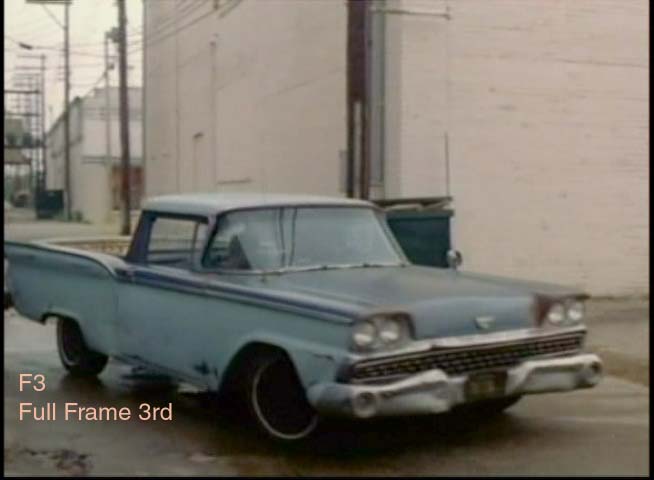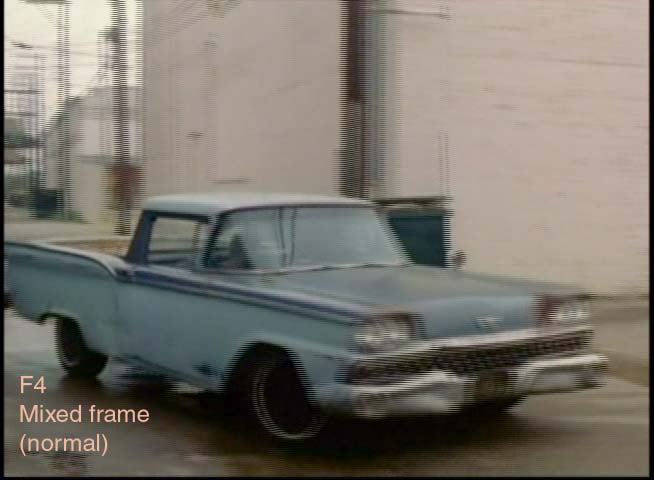I'm pretty sure that for de-interlacing for PC playback, inverse telecine is the best possible solution (also the lower frame rates allow for better quality/lower file size).
I'm just wondering when is this alternative possible.
I'm capturing two sources (both in DV), one from a VCR and one from digital satellite. Is inverse telecine a solution for me???
I'm just looking for some confirmation because i've been reading that it's not possible to use with a DV format.
Anyways let me know what you guys think????
+ Reply to Thread
Results 1 to 13 of 13
-
-
It's not possible for camcorder recordings from the CCD that are almost always interlace. There are progressive modes for some advanced camcorders but that is a different subject.
If you use the camcorder as a 480i VCR or to capture (pass through) and the source is film based, then you can use IVTC just like you can from a normal VCR.
If you step frame by frame through the video and see frames like these in a repeating pattern, then the source is film.

 Recommends: Kiva.org - Loans that change lives.
Recommends: Kiva.org - Loans that change lives.
http://www.kiva.org/about -
Well hello EdDV...you have come to my rescue yet again. I really wish i could hire you to come to my house so I could just have a sit down and talk about all my questions hahaha.
Anyways, so from what i got from your post is that as long as the source is film based, it is possible.
So am i correct in assuming that any (or vast majority) of shows that i capture in DV are candidates for inverse telecine?
- Thanks
Also, on a side note, quick quesiton, is virtual dub the best method of acheiving this (inverse telecine), or is the script based program i have been trying to avoid AVIsynth the best way? -
Many tv shows are far away from film. They were edited and had CG done in interlace domain.
Want my help? Ask here! (not via PM!)
FAQs: Best Blank Discs • Best TBCs • Best VCRs for capture • Restore VHS -
You can try it in virtual dub "Reconstruct from fields - adaptive" or manual or you can try it with your encoder (e.g. TMPGEnc, etc.) or try AVIsynth later if you want more. Doom9 has good guides and there are probably some here.
Virtual dub "Reconstruct from fields - manual" is a good way to experiment.Recommends: Kiva.org - Loans that change lives.
http://www.kiva.org/about -
well i have tried on it a source but i'm assuming it wasn't possible because when i tried it in virtual dub it completly messed with the video...all colors went off and everything was scambled.
You think its safe to use a broadcast movie? -
Usually, but you never know how they have processed it.
Maybe they sped it up it to make room for more commericals. Practice on a laserdisc or NTSC out on a DVD or some other movie source.Recommends: Kiva.org - Loans that change lives.
http://www.kiva.org/about -
will try that, and will also try to post results
may take a while as i'm upgrading PC!!
-
Ok, i've hit a road block.
In virtual DUB i have captured broadcast footage and it all has the 3 progressive 2 interlaced pattern decribed as a characteristic of video that can undergo inverse telecine.
However, when I direct Virtual Dub to perform IVTC, the encoded video is totally messed up! When i mean messed up I mean all colors turning to pink and yello and picture becoming scambled.
Please let me know whats happening. THANKS. -
I'd suspect it was something else rather then the IVT routine causing prob. -- easy way to tell is just uncheck IVT & process a short test. In general all IVT will do is (depending on settings) try to drop frames added when going from 24 p to 29.97 i.
-
ok could someone guide me to a source that would be a good canditate for inverce telecine? I'm apparently having trouble finding a good source and to date, i have not seen IVT work it's magic.
-
Hi-
If you're going to IVTC anything, you'd best learn AviSynth, as its various IVTCs (Decomb, TIVTC, SmartDecimate, etc.) are way better than VDub's and better than TMPGEnc's as well, unless you like spending hours doing it manually.
As for sources, you're looking for DVD sources that are 0% Film when you create a D2V project file using DGIndex, yet display the telltale 3 progressive followed by 2 interlaced frames in every 5 frame cycle, that is, movies already telecined and encoded as 29.97fps interlaced. There are a ton of such DVDs. I finished one today:
http://www.amazon.com/gp/product/B0007XPQE0/qid=1140598613/
NetFlix carries it, if you belong to them. Most foreign films (i. e., non-US), particularly Asian films, put out by non-US production companies are encoded that way and if DVD9, will definitely bnefit from IVTC. European films for NTSC are often PAL2NTSC and are horribly blended and have to be unblended, as opposed to being IVTC'd. -
Also, a lot of anime TV series DVDs are a mix of soft telecined film and hard telecine, and can also benefit from IVTC. The perennial favorite Cowboy Bebop is one example. It is quite hard to do successsfully. Plus, its credits are true 29.97fps interlace. If doing it for DVD, I encode the credits separately and join them to the rest when authoring.
The first GITS-SAC has some 30fps progressive scenes, but the 2nd Gig DVDs are all a mix of hard and soft telecine and should also be IVTC'd.
Similar Threads
-
mpeg1 in reverse?
By dullrazor in forum Newbie / General discussionsReplies: 5Last Post: 26th Nov 2009, 13:17 -
How to reverse a M2V file
By lorix in forum EditingReplies: 2Last Post: 13th Nov 2008, 05:09 -
Encoding in reverse direction
By Someguy2 in forum EditingReplies: 8Last Post: 15th Jan 2008, 06:49 -
Speed/reverse in iMovie HD
By ker-plop in forum MacReplies: 3Last Post: 1st Nov 2007, 08:31




 Quote
Quote